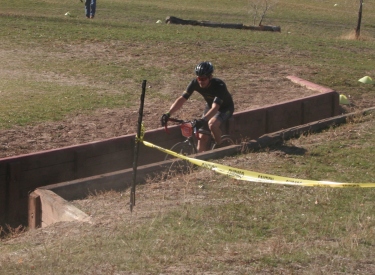 |
Introduction to Cyclocross Racing
Cyclocross, "CX" for short, is a fun and unique type of
bicycle racing. To understand cyclocross, pretend that road-bike racing and mountain
biking hooked up for an irresponsible night of passion. And, they had a baby. Then... they got
their kid drunk.
That drunk child is cyclocross. |
 |
You can do cyclocross on a mountain bike. But the best
riders will be on bikes made specifically for cyclocross.
A cyclocross (CX) bike looks like a road bike. The
handlebars and shifters are like a road bike. But the frames are
stronger. The frame geometry is tweaked to improve bike handling in bumpy
spots and tight turns.
|
 |
The wheels on a CX bike are stronger so they can hit rocks and roots.
Tires are bigger than a road bike -- although still only about half the
diameter of a standard mountain bike tire. The tires have tread for
traction in snow,
mud, and sand.
Cyclocross bikes may use disc brakes or cantilever brakes. Standard
roadie brakes would get clogged with mud. |
 |
When getting started with cyclocross, some racers will
put small tires on their racing mountain hardtail. That's fine. Riding your
mountain bike is a cheap way to test the waters to see if you like
cyclocross. Here's a thought: borrow a CX bike from a friend who'll be
racing later in the day. Once you're addicted, you'll want a CX bike.
|
 |
To create a cyclocross course, the promoter will usually
select a park that includes some wild territory. Mountains are generally
avoided, because the object is to zip around at lightning speed, not to
grunt uphill forever. There needs to be plenty of parking, because several hundred
bikers may show up. |
 |
A good cyclocross course will have plenty of turns and
varied terrain. The loop will be usually be just over a mile in length.
The route will be outlined with barrier tape and cones.
An absolute requirement of CX are barriers that make you jump off
your bike and jump back on again. It might be a log, a ditch, a set of
stairs, or barriers made specifically for cyclocross racing. |
 |
Sometimes the barrier lets the best riders jump over it.
But dismounting, jumping the barrier, and hopping back onto the bike are
critical cyclocross skills that riders will practice. Expert racers are
so smooth and fast that you hardly notice they got off the bike. |
 |
The CX course will hit as many different trail surfaces as
possible. There will be some grass, some smooth trail, some sidewalk,
some pavement. But expect an occasional helping of sand, cobble, mud,
roots, and if you're lucky, snow. The idea is to serve up challenges to
your bike handling. |
 |
Where possible, a cyclocross course will also include a
"run-up" which is a hill that's too steep or loose to ride.
And just to keep the hotshots honest, there's often a barrier at the
bottom of the hill so you're forced to run up. |
 |
The best cyclocross courses have plenty of spots to pass.
But there will be occasional choke points to make things interesting.
Make your move to get there first. |
 |
Racers sign up for a category based on their ability. For
example, Men A are the blazing fast experienced racers, while Men C are
beginners. There are Clydesdales (heavier racers) and Masters (old guys)
and other special categories based on age, sex, and ability.
Popular cyclocross events will have multiple races about an
hour apart. The idea is to have riders of similar speed and
aggressiveness on the course at the same time. Within each race, there
may be several "waves" of racers. For example, Masters
55-plus, Men C, and Clydesdale might be sent out a minute or two apart. |
 |
Racers who are in the lead for the season will be called
up to the front row as each racing category is organized at the start
line. This is called staging.
When the official says "go," racers take off on a wide area
of the race loop that spreads the group out as the faster riders sprint
ahead. You'll be racing for 40 to 50 minutes, depending on the category. |
 |
CX is a very intense type of racing. You aren't racing
for a long time, but you're going all out. You're not saving anything.
After each turn or barricade, you sprint.
Racers will make several laps around the loop. But you won't really
know how many laps until the race is half over. Here's why. |
 |
A cyclocross race has a pre-set time, not a set distance. Once
the fastest riders have finished a couple of laps, the race officials
calculate how many more laps will be done in the allowed time. Then they
call out the remaining laps for all riders. But once the fastest riders
cross the finish line on that final lap, all riders are finished the next time they cross the
line. If you were lapped, tough. You're done. |
 |
Cyclocross season is typically in the fall. The cool
temperatures let you go all-out without cooking. And later, when the
ground is slimy and there's snow on the roots, that's even more
fun! |

|

















